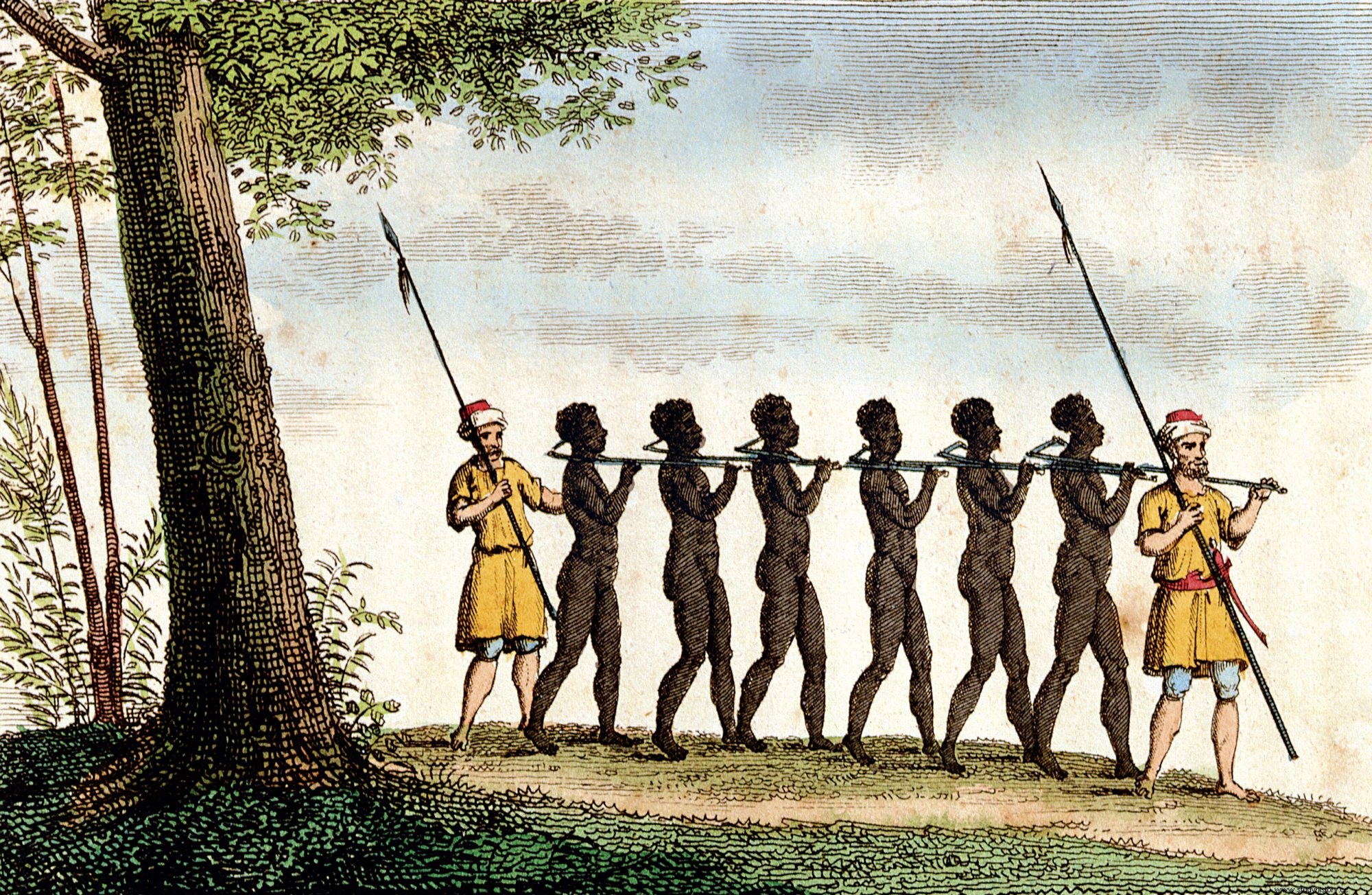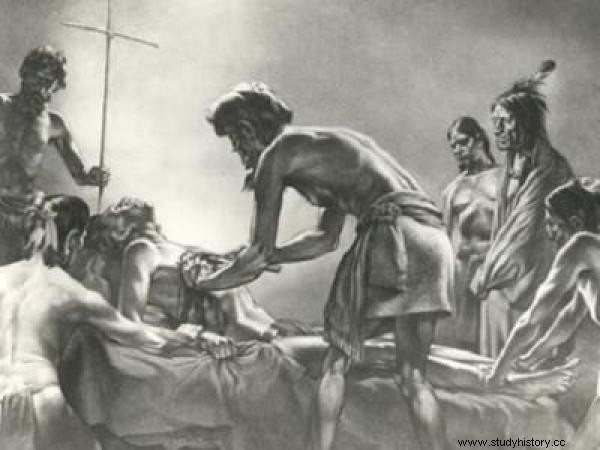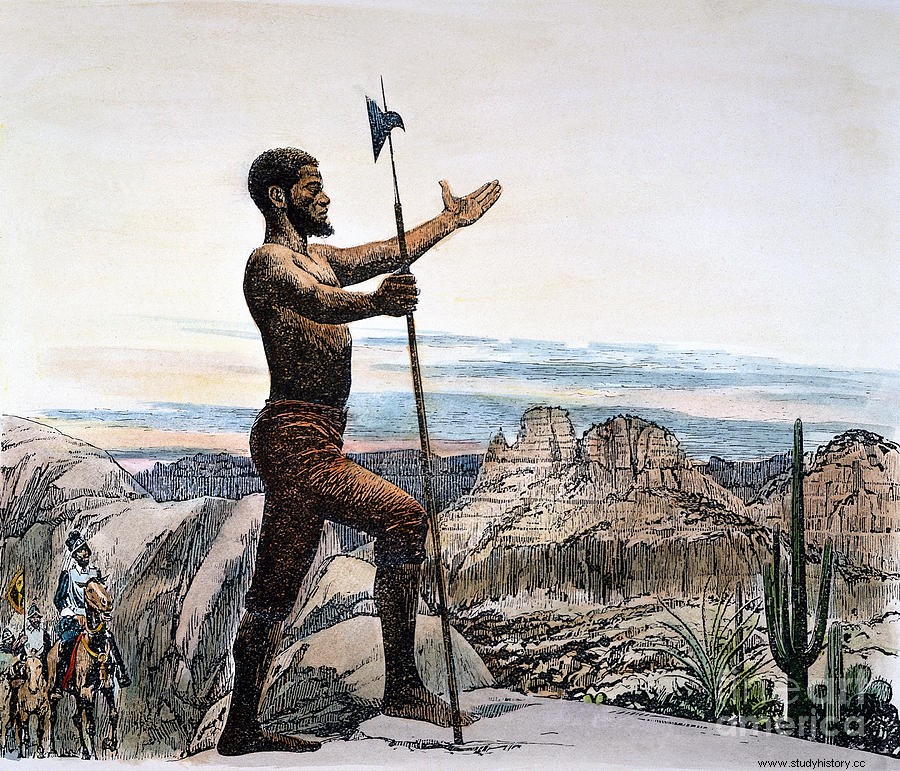Since the 8th century, the Muslims, who controlled North Africa, bled the African continent of its human resources in every possible way. The spread of Islam into so-called "Black Africa" entailed the capture of millions of slaves who were shipped north via routes across the Sahara, and to the Arabian Peninsula via Red Sea and Indian Ocean ports. With the arrival of the Portuguese on the African continent in the fifteenth century, they would be the ones who would take control of the slave trade on the west coast. Until the end of the 15th century, the slave trade was almost exclusively in the hands of the Arabs and the Portuguese:the Arabs supplied the Eastern world and the Portuguese supplied the Western powers. The discovery of the American continent and the subsequent "need" for labor to work in the plantations and mines, opened a new way to dispose of the slaves captured in Africa. And although the Spanish colonies in the American continent would be the first to use African slaves, the so-called Atlantic slave trade was controlled almost exclusively by the Portuguese during the 16th century. The Spanish monarchy preferred not to "dirty their hands" and used the black seats , commercial agreements of the Crown with other monarchies, or with individuals, to provide the American possessions with slaves in exchange for receiving a percentage of the profits from the sale.

One of these Africans enslaved and sold by the Portuguese was the protagonist of this story, Estebanico -also called Estevanico, Esteban el Negro or Esteban el Moro-. We know nothing about our protagonist until he was captured in 1513 and sent to Portugal with the new Christian name that his captors gave him... Estebanico . The next news we have of Estebanico is in June 1527. As a slave of Andrés Dorantes de Carranza , he is one of the members of the expedition led by Pánfilo Narváez who left Sanlúcar de Barrameda (Cádiz) on June 17, 1527 to colonize Florida. After resupplying in the Canary Islands, at the end of September they arrived in Santiago de Cuba. From there, one mishap after another:desertions, storms that divert the ships from the route, hurricanes that sink them, wrong decisions... until April 1528 they would not reach their destination in Tampa Bay (Gulf of Mexico). After the first contacts with the natives of the area, in this case peaceful, Narváez decided to divide the force into a land and a maritime contingent:300 men by land to the north and the ships, with the rest of the expedition, would sail by the coast to meet them. The land contingent managed as best they could until they entered Appalachian territory . The harassment of these and the lack of supplies forced Narváez to abandon the idea of going further north and decided to return to the coast. About 240 men, some horses, hardly any food, no tools... and in front of them the sea, the only way to escape from him. They had to build a rudimentary forge to melt their armor and make tools to build rafts, endure the harassment of the Appalachian, feed on the horses... but on September 22, five barges abandoned that adventure following the coast to reach Mexico. 
Narváez expedition and route of the 4 survivors
After two months of storms, disease, thirst and hunger, a hurricane sank the remaining barges near Galveston Island, off the Texas coast…the expedition had been reduced to just 80 men. With what they were wearing, the survivors of the shipwreck entered the southern lands of present-day Texas. During the following four years in that unknown world, their number was reduced until in 1532 only four men remained out of the initial 300:Álvar Núñez Cabeza de Vaca, Alonso del Castillo Maldonado, Andrés Dorantes de Carranza and Estebanico . Exhausted, hungry and aimless, they were captured by the natives and enslaved. Thanks to Cabeza de Vaca's medical knowledge -among the natives he was considered a healer- and Estebanico's ability to learn languages and his skills as a negotiator, even acting as an intermediary between several tribes, they managed to stay alive... and escape when they met forces.

Cabeza de Vaca curing a native
After wandering through the extensive area that is now the border between Mexico and the United States, they arrived at the Rio Grande area. Following the course of the river they found tribes dedicated to bison hunting with whom they lived for a time. Finally, on the banks of the Sinaloa River they found a group of Spanish explorers and with them they returned to Mexico (capital of the Viceroyalty of New Spain). Eight years had passed since they left Cuba. The Viceroy of New Spain, Antonio de Mendoza y Pacheco , he received the survivors and wanted to know all the details of that deed. In addition to their personal experiences, the survivors included in their story the stories they had heard from the natives about riches and fantastic cities... which sparked the medieval legend of the Seven Cities of Cíbola (let's say the version of El Dorado , but further north). The viceroy quickly organized an expedition to locate that myth in the area traveled by the survivors. The three Spaniards resigned to participate:Alonso del Castillo and Andrés Dorantes married two rich widows and stayed to live in Mexico; for his part, Cabeza de Vaca returned to Spain and managed to be awarded the title of second advanced of the Río de la Plata, in addition to publishing Shipwrecks , a story in which he describes his experiences and those of his three companions crossing the southwestern United States and northern Mexico on foot.

Stephanie
And what happened to Estebanico?
Dorantes ceded the "property" of the slave to the viceroy and the latter appointed him explorer and guide of the expedition that was going to search for the Seven Cities . Although Fray Marcos de Niza was in charge From the first moment, Estebanico, knowledgeable about the area, took charge of that adventure... and of his destiny. As the guide of the expedition, he told Fray Marcos that he would need the help of some natives from the tribes he met on his previous odyssey. Since the request seemed logical, Fray Marcos agreed. Estebanico and the natives went ahead, a couple of days away, and the explorer sent emissaries to the bulk of the expedition with what they found on their way. The news that reached the expedition made them believe that they were approaching the rich cities bathed in gold... and Estebanico was shaping his plan. When the time came, the native emissaries arrived with the news that Estebanico had died at the hands of some belligerent natives, the zuñi -located in what is now the state of New Mexico, USA-. Faced with the threat of continuing on and losing his life at the hands of hostile natives, Fray Marcos de Niza decides to believe the news of Estebanico's emissaries and returns to Mexico City to inform the viceroy of the discovery of the Seven Cities. . The official version places Estebanico's death in 1539, when he was an explorer for the viceroy of New Spain and the first African to set foot in the southwestern part of what is now the United States and northern Mexico.
The reality, Estebanico faked his death to get his freedom and lived the rest of his days among the Zuni. Fray Marcos de Niza told the viceroy about his incredible discovery…
He has a very beautiful appearance of a town, the best that in these parts
I have seen; the houses are the way the Indians told me,
all of stone with their leftovers and açuteas, as it seemed to me
from a hill where I stood nearby. The population is greater than
Mexico City; Sometimes I was tempted to go to her, because
I knew that I was risking nothing but life, and this I offered to God the day that
I began my journey; In the end I feared, considering my danger and that if
I died, it would not be possible to make sense of this land, which in my opinion is the
greatest and best of all the discovered ones. When I told the
principals I had with me how well Cíbola seemed to me, they told me that it was the least of the seven cities
[the friar was not lacking in imagination]
The viceroy sent a second expedition led by Francisco Vázquez de Coronado to find the place but the search proved that the story was false… and Estebanico had gotten away with it.
